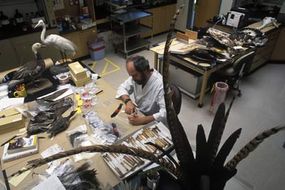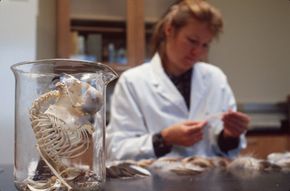Animal Forensics
Investigators examine bone fragments, a pool of blood and other details of a crime scene. The puzzle they're putting together might sound like an episode of "CSI," but these detectives are using forensic science to piece together a case of alleged animal abuse.
The ASPCA was one of the first organizations to get on board with animal forensics as an investigative tool, launching a veterinary forensics unit and dispatching the first animal crime scene mobile unit, equipped with X-ray machines, computers, examination tables and video equipment.
Advertisement
The U.S. Department of the Interior is also doing groundbreaking work in animal forensics. Its work started in the 1970s when Terry Grosz, a special agent of the Division of Law Enforcement for the U.S. Fish and Wildlife Service, was assigned to coordinate all endangered species investigations around the country. How? Grosz envisioned a forensics laboratory similar to that of an FBI laboratory that studies physical evidence from human crime scenes -- except these victims would be animals.

His vision began to take form when Ken Goddard, a former police crime laboratory director, was hired by the U.S. Fish and Wildlife Service to set up such a program. In 1988, the U.S. Fish and Wildlife Service Forensics Laboratory opened in Ashland, Oregon. Today, the laboratory is still the only one of its kind in the world.
The laboratory's mission is to help federal and state law enforcement officers and inspectors in all 50 states, as well as 173 countries. The forensics team conducts crime scene investigations, determines cause of death and if a crime occurred, and examines physical evidence in an attempt to link victim and crime scene with suspect. Laboratory specialists can also provide expert testimony in court.
The laboratory is organized into seven branches: administration, chemistry, criminalistics, genetics, morphology, pathology and digital evidence. Currently, a team of 33 people handles roughly 900 cases every year [source: Pahl].
Scientists here work with items such as bones, blood, hair, feather, fur, teeth, tusks, talons, poisons, strips of leather and any other part of an animal's anatomy. These branches use chemical, instrumental, microscopic and other high-tech techniques to study specific crime scene evidence in an effort to determine a piece of the puzzle. For example, forensic scientists in the pathology branch examine carcasses, wounds and even stomach contents in an effort to determine cause of death. Their counterparts in the genetics branch are able to identify a victim's species and gender from a drop of blood or piece of tissue, based on protein and DNA analysis.
Let's leave the forensics laboratory and find out what it takes to become an animal detective next.
